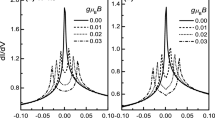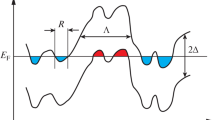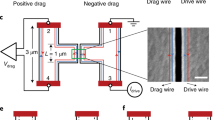Abstract
As it is known, the role of Coulomb correlations in hopping transport is still not understood in detail and different works contain controversial conclusions in this concern. In what follows, we are going to consider an effect which is completely controlled by the Coulomb correlations. Namely, we mean the Coulomb drag between two-dimensional hopping insulators. Assuming that the principal role is played by the critical resistors in both the active layer and the passive one, we have analyzed the “ratchet” mechanism of the drag. The effect consists of the modulation of an activation energy in the “passive” resistor by the non-equilibrium electric dipole formed on the “active” resistor in the presence of electric field. The dipole originates due to a hop of a single electron and has a transient character. Namely, the effect of this non-equilibrium dipole on the “passive” resistor takes place at the timescale shorter than typical relaxation times for an establishment of the equilibrium in the “passive” plane. The latter fact is of principal importance. The effect vanishes in a sample with infinite size in the plane provided that the distance between the layers is large enough. For finite-size samples, both the effect magnitude and sign depend on the sample’s size. We have analyzed the dependencies in relevant limiting cases. It is important to note that the effect drastically depends on the distance between the two planes. Thus, we hope that studies of this effect can, in particular, throw light on the role of Coulomb correlations in hopping transport. We have compared the results with those of previously published papers.



Similar content being viewed by others
Notes
Main concepts of hopping conductance and percolation theory are excellently reviewed by Shklovskii and Efros [31].
References
M.B. Pogrebinskii, Fiz. Tekh. Poluprovodn. 11, 637 (1977). [Sov. Phys. Semicond. 11, 372 (1977)]
P.M. Price, Physica (Amsetrdam) 117B, 750 (1983)
P.M. Solomon, P.J. Price, D.J. Frank, D.C.L. Tulipe, Phys. Rev. Lett. 63, 2508 (1989)
B. Laikhtman, P.M. Solomon, Phys. Rev. B 41, 9921 (1990)
T.J. Gramila, J.P. Eisenstein, A.H. MacDonald, L.N. Pfeiffer, K.W. West, Phys. Rev. Lett. 66, 1216 (1991). https://doi.org/10.1103/PhysRevLett.66.1216
U. Sivan, P.M. Solomon, H. Shtrikman, Phys. Rev. Lett. 68, 1196 (1992)
H.C. Tso, P. Vasilopoulos, F.M. Peeters, Phys. Rev. Lett. 68, 2516 (1992). https://doi.org/10.1103/PhysRevLett.68.2516
A.P. Jauho, H. Smith, Phys. Rev. B 47, 4420 (1993). https://doi.org/10.1103/PhysRevB.47.4420
L. Zheng, A.H. MacDonald, Phys. Rev. B 48, 8203 (1993). https://doi.org/10.1103/PhysRevB.48.8203
K. Flensberg, B.Y.K. Hu, A.P. Jauho, J.M. Kinaret, Phys. Rev. B 52, 14761 (1995). https://doi.org/10.1103/PhysRevB.52.14761
K. Flensberg, B.Y.K. Hu, Phys. Rev. Lett. 73, 3572 (1994). https://doi.org/10.1103/PhysRevLett.73.3572
K. Flensberg, B.Y.K. Hu, Phys. Rev. B 52, 14796 (1995). https://doi.org/10.1103/PhysRevB.52.14796
H.C. Tso, P. Vasilopoulos, F.M. Peeters, Phys. Rev. Lett. 70, 2146 (1993). https://doi.org/10.1103/PhysRevLett.70.2146
L. Świerkowski, J. Szymański, Z.W. Gortel, Phys. Rev. Lett. 74, 3245 (1995). https://doi.org/10.1103/PhysRevLett.74.3245
G. Vignale, A.H. MacDonald, Phys. Rev. Lett. 76, 2786 (1996). https://doi.org/10.1103/PhysRevLett.76.2786
A. Kamenev, Y. Oreg, Phys. Rev. B 52, 7516 (1995). https://doi.org/10.1103/PhysRevB.52.7516
Y. Oreg, A. Kamenev, Phys. Rev. Lett. 80, 2421 (1998). https://doi.org/10.1103/PhysRevLett.80.2421
I.V. Gornyi, A.G. Yashenkin, D.V. Khveshchenko, Phys. Rev. Lett. 83, 152 (1999). https://doi.org/10.1103/PhysRevLett.83.152
E. Shimshoni, Phys. Rev. B 56, 13301 (1997). https://doi.org/10.1103/PhysRevB.56.13301
R.V. Gorbachev, A.K. Geim, M.I. Katsnelson, K.S. Novoselov, T. Tudorovskiy, I.V. Grigorieva, A.H. MacDonald, S.V. Morozov, K. Watanabe, T. Taniguchi, L.A. Ponomarenko, Nat. Phys. 8, 896 (2012). https://doi.org/10.1038/nphys2441
A.V. Khaetskii, Y.V. Nazarov, Phys. Rev. B 59, 7551 (1999). https://doi.org/10.1103/PhysRevB.59.7551
M.C. Bønsager, K. Flensberg, B.Y.K. Hu, A.P. Jauho, Phys. Rev. Lett. 77, 1366 (1996). https://doi.org/10.1103/PhysRevLett.77.1366
M.C. Bønsager, K. Flensberg, B.Y.K. Hu, A.P. Jauho, Phys. Rev. B 56, 10314 (1997). https://doi.org/10.1103/PhysRevB.56.10314
F. von Oppen, S.H. Simon, A. Stern, Phys. Rev. Lett. 87, 106803 (2001). https://doi.org/10.1103/PhysRevLett.87.106803
E. Shimshoni, S.L. Sondhi, Phys. Rev. B 49, 11484 (1994). https://doi.org/10.1103/PhysRevB.49.11484
I. Ussishkin, A. Stern, Phys. Rev. B 56, 4013 (1997). https://doi.org/10.1103/PhysRevB.56.4013
S. Sakhi, Phys. Rev. B 56, 4098 (1997). https://doi.org/10.1103/PhysRevB.56.4098
Y.B. Kim, A.J. Millis, Physica (Amsterdam) 4E, 171 (1999)
B.N. Narozhny, I.L. Aleiner, A. Stern, Phys. Rev. Lett. 86, 3610 (2001). https://doi.org/10.1103/PhysRevLett.86.3610
M.E. Raikh, F. von Oppen, Phys. Rev. Lett. 89, 106601 (2002). https://doi.org/10.1103/PhysRevLett.89.106601
B.I. Shklovskii, A.L. Efros, Electronic Properties of Doped Semiconductors, Springer Series in Solid-State Sciences, vol. 45 (Springer, Berlin, 1984)
R. Sánchez, R. López, D. Sánchez, M. Büttiker, Phys. Rev. Lett. 104, 076801 (2010). https://doi.org/10.1103/PhysRevLett.104.076801
M.A. Sierra, D. Sánchez, A.P. Jauho, K. Kaasbjerg, Phys. Rev. B 100, 081404 (2019). https://doi.org/10.1103/PhysRevB.100.081404
M.J. Buckingham, Noise in Electronic Devices and Systems (Ellis Horwood, New York, 1983)
C.R. Doering, Physica A Stat. Mech. Appl. 254(1), 1 (1998). https://doi.org/10.1016/S0378-4371(98)00006-5
Acknowledgements
Financial support from RFBR, Grant No. 19-02-00184, is greatly acknowledged. We also acknowledge J. Bergli and A. V. Shumilin for stimulating discussions.
Author information
Authors and Affiliations
Corresponding author
Additional information
Publisher's Note
Springer Nature remains neutral with regard to jurisdictional claims in published maps and institutional affiliations.
Appendix A: Estimate of the Asymmetry
Appendix A: Estimate of the Asymmetry
As it is known, see, e.g., [31], the hopping rates for the two sites i and j can be estimated as
Here, \(c_{ij}\) is a pre-factor independent of the sites’ energies including tunneling matrix elements and constant of electron–phonon interaction; it is assumed that here \(\varepsilon _j > \varepsilon _i\), N is the Planck function, while f is the Fermi function of the corresponding energy. In the absence of the applied electric field, \(\gamma _{ij} = \gamma _{ji}\). Indeed, in this case the hop from the lower energy state to the higher energy state (\(i\rightarrow j\)) costs the corresponding activation energy; however, the hop in the opposite direction (non-activated) has a lower probability for the initial site, j, to be occupied.
For simplicity, we will also assume that the site i has an energy below the Fermi level, while the site j has an energy above the Fermi level. Actually, our approach would allow to consider another realizations as well. However, it is clear that if the effect exists at least for one type of realizations, it will contribute to the sample as a whole. Thus, we expect that the most of the time the site i is occupied (\(f_i \sim 1\), while the site j the most time is empty (\(f_j<< 1\)). It is the factor N which ensures for the equilibrium the charge transfer over the resistor in both directions to be equal. In our case, we have in mind that the energy difference \(\varepsilon _j - \varepsilon _i\) acquires non-equilibrium addition related to coupling to the non-equilibrium dipole in the passive plane.
One notes that it is this activation energy that enters the arguments of phonon distribution function N which is sensitive only to phonon relaxations and naturally is expected to be an equilibrium one. Nevertheless, one could expect that the electron occupation numbers would tend to its equilibrium values. It is clear that in the latter case (that is for equilibrium in the electron system with the perturbed energies) no effect would exist.
At the same time, while the activation energy is instantly changed due to an effect of transient dipole, the distribution functions still have the values which existed before the transient process takes place. Indeed, the relaxation of the occupation numbers takes a time of the order of \(\tau _\mathrm{h}\); that is, during this time one can consider the occupation numbers to be unchanged. We have in mind that it is the same time which, on the one hand, is necessary for the electron to cross the “passive” effective resistor, thus participating the drag current. Secondly, it is the time duration for the transient dipole to exist. Thus, we conclude that with a probability of the order of unity the drag process takes place during the dwell time of the transient dipole and during the time when the occupation of the corresponding site is not changed.
As a result, the hopping probabilities become asymmetric since the activation concerns mostly the process related to an absorption of a phonon. The effect can be estimated if we substitute to the activation factor related to the Planck function N the transient energies including the addition related to the coupling energy U: \( (\varepsilon _j - \varepsilon _i ) \rightarrow \varepsilon _j - \varepsilon _i + U\). Expansion of the function N in terms of small addition U / kT gives estimate (15) presented in the text.
Rights and permissions
About this article
Cite this article
Kozub, V.I., Galperin, Y.M. Coulomb Drag in Mesoscopic Hopping Insulators. J Low Temp Phys 198, 209–223 (2020). https://doi.org/10.1007/s10909-019-02292-6
Received:
Accepted:
Published:
Issue Date:
DOI: https://doi.org/10.1007/s10909-019-02292-6




